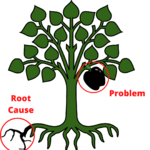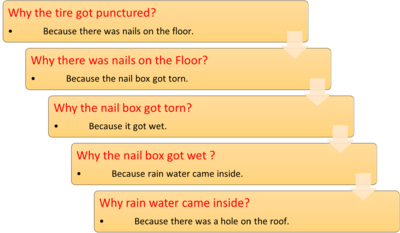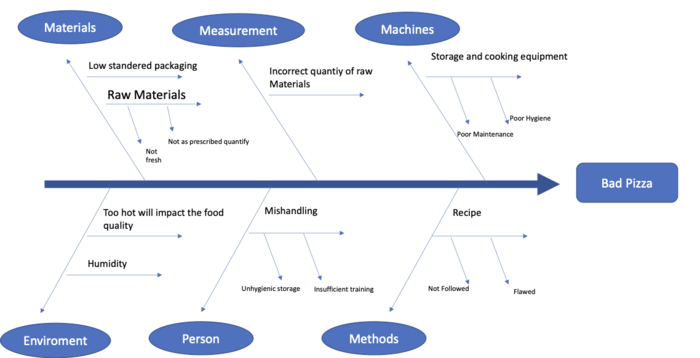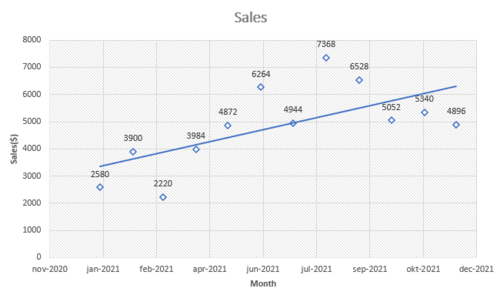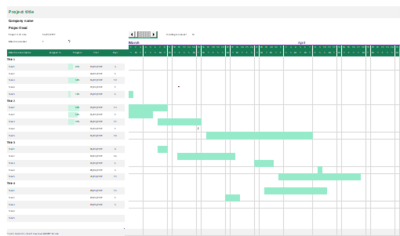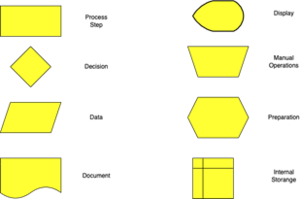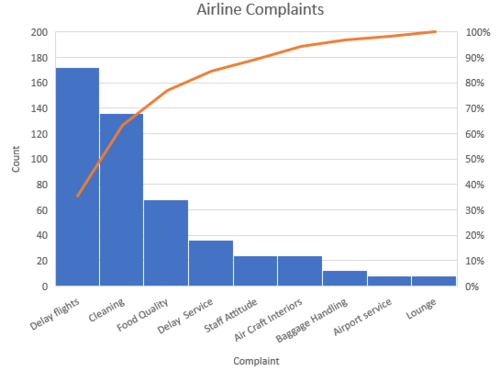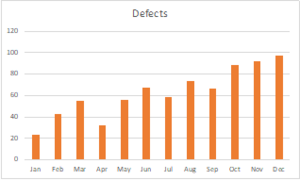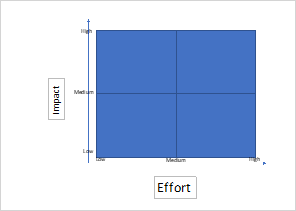Root cause analysis (RCA)
Abstract
While managing programs or projects we face many challenges which affect the schedule or quality of the project. For the elimination of such similar future challenges, it is important to identify from where the problem has started (Root Cause). Root cause analysis is a method to identify the source of the problem and to know how it has happened and how to prevent such problems in future. Multiple industries like Construction, manufacturing, pharmaceutical, Information technology uses this method for successful identification of causes for the problem. RCA also gives the scope to identify the gaps in the existing process, reduce the cost of production or increase production. This article we will give a brief idea about What is Root Cause Analysis(RCA) and its importance, when and how RCA has to be done and methods of doing root cause analysis.
Contents |
Introduction
Root cause analysis (RCA) is an important aspect of a broad problem-solving process and continuous improvement. A root cause is a part that contributed to a failure and should be removed completely using process improvement. The root cause is the most fundamental problem—the most fundamental reason—that puts in motion the a whole cause-and-effect that leads to the problem.
Root cause analysis refers to a variety of methodologies, tools, and procedures used to identify the root causes of issues. Some RCA approaches are more focused toward finding actual root causes than others, while others are more broad problem-solving procedures, but others simply provide support for the root cause analysis core activity.[1]
Process of Root cause Analysis
Below table shows purpose, output ,Success factors and tools that has to be used in each step.
| Step | Purpose | Output | Success Factors | Tools |
|---|---|---|---|---|
| Define the Event | Know the Problem | Problem statement | Being Specific and objective | Interview |
| Come up with the starting point | RCA Team | No assumptions on what created the problem | Gantt Chart | |
| Create a RCA team | Project plan | Team balance | Survey | |
| Design a project plan | Planning the Schedule considers goals and time. |
| ||
| Find cause | Know the Problem better | List potential causes for the problem | No filtering or prioritizing the Potential causes | Flowchart |
| Bigger picture on the possible causes |
|
Creative thinking | High-Level Mapping | |
| Make sure that everyone in the team knows whats happening about the problem |
|
Deep dive into the data and evidence of the problem | Brainstorming | |
|
|
Fishbone diagram | |||
| Find the root cause | Detect the real root cause for the problem | Interpretation of the Root Cause | Having a calm and logical mindset | Cause and event tree |
|
|
|
Don’t conclude with the root cause too quickly | Five Whys | |
|
|
|
|
Histogram | |
|
|
|
Pareto analysis | ||
| Find solutions | Plan a feasible solution to eliminate the root cause | Explanation of solutions | Including those with idea with possible solutions | Flowchart |
|
|
|
Including those who will be impacted with possible solutions | Brainstorming | |
|
|
Ownership for the needed changes | The "Why Not" Principles | ||
|
|
|
Survey/Interviews | ||
| Take Action | Executing the solutions | Applied solutions | Able to push beyond | Force Field Analysis |
|
|
Focusing on long term changes
|
Including those who will have to modify the work structure | Impact effort matrix | |
| Measure and assess | Evaluate the change results | Confirming the right solutions to the problem | Stay critical in the evaluating the solutions | Pilot study |
|
|
Evaluate the future change requirement | Report | Don’t be in hurry to complete the project and submit the report | |
|
|
Complete the RCA project |
Root cause analysis tools
Five Why analysis
Five Why analysis is widely used root cause analysis tool in the industry as it helps to identify the root cause with few simple “WHY” question and without in need of any statistical tool. This method is one of the fasted methods to know the real root cause of the problem. In 1930s this tool was developed by Sakichi Toyoda, Founder of Toyota Industries, but only in 1970s this tool was used in many industries. [2]
Steps to perform five why analysis
- Take a particular problem
- Question “WHY” it occurred and note down the answer.
- If that is not the exact root cause then you can ask another “WHY” question to that answer .Note down the new answer.
- Follow these steps till you identify the root cause. It can take any number of “WHY” to reach the cause. [3]
Example
Problem: Car Tire got punctured
Root Cause: There was a hole on the roof.
Remedy: To avoid car tire puncture like this we need to fix the hole on the roof
Fishbone diagram
Fishbone diagram was developed by Kaoru Ishikawa. Hence, it is also known as the “Ishikawa diagram”. This method is done through a diagram which looks like a fishbone. The diagram shows the main and sub cause for that result. Usually, the diagram is made through team brainstorming. In this the effect or the problem will be in the place of fish head and the primary and sub cause will be there in bone of the fish. [4]
This method is commonly used in various manufacturing and operations industry . Instead of focusing on a single cause, this approach provides us with a comprehensive list of all probable causes, which aids not only in discovering the core cause of the current problem but also in preventing future mishaps.
Steps to analysis fishbone diagram
- Determine and state the effect or the problem that has to be analyzed.
- Determine the primary causes or categories of the effect.Methods, machines, people, materials, environment or measurements are popular primary causes.
- Under each primary categories identify the other sub causes on it.
- This procedure of analyzing each cause is repeated until the problem's root causes are found. The team then analyzes the fishbone diagram until a conclusion and future steps are reached.[5]
Example
Image recreated from Wall street mojo[6]
Scatter chart
Scatter chart represents the relationship between dependent and independent variables for the root cause. The dependent and independent variables data is represented by numerical value. [7]
Steps to create a scatter plot
- Choose two variables to analyze (Pair of dependent and independent variables).
- Measure the equivalent value of the dependent variable for each value of the independent variable.
- On the chart, plot the numbers from each data pair.
- On the horizontal axis, place the independent or expected cause variable, and on the vertical axis, place the dependent or intended effect variable.
- In the chart, plot and examine the acquired data values. [7]
Example
Gantt charts
In today’s industry nearly 95% of the projects uses Gannt charts for their projects as it is one of the best indication tool. Gantt chart helps to keep a track on the progress of the project. Gantt chart helps to keep a track on the progress of the project. [7]
Steps to create a Gantt chart
- Make a list of all tasks and activities and Calculate the latest finishing date and the earliest start date for each activity, as well as the duration and any interdependence on other activities.
- Arrange the tasks in a blank Gantt chart, with the timeline indicating the project's overall duration.
- Draw bars that match to the duration of the activities to schedule them.
- Use diamonds to represent plan milestones. [7]
Flowcharts
Flowchart represent the process flow which was used through a simplified representation. [7]
Steps to create flowcharts
- Gather all of the team members in the process in a meeting room with a whiteboard and plenty of colorful sticky note
- Define the process's beginning and end points, as well as the borderline between other parallel processes.
- List the primary actions or tasks that were completed during the procedure
- Use different colored adhesive notes to represent actions, items, documents, and other process elements.
- Draw a diagram of the process by shifting the notes about on the board until they reflect the most accurate representation of the process. [7]
Symbols
Pareto analysis
Pareto principle was formed after Vilredo Pareto, an Italian economist, he designed a principle to represent 80% of wealth in the country is owned by 20% of the people. Pareto analysis is a helpful tool when there are several influencing factors for the results. Pareto analysis helps to develop and organize ideas. This tool primary assists the user to figure out top 20% of the root cause which can affect 80% end results.Hence, it is popularly known as 80/20 rule. [8]
Pareto analysis can also be helpful and give deeper understanding of the problems that must be addressed on priority. A Pareto chart may also be used to estimate the cumulative effect of a problem. To put it in another way, cumulative impact is the result of a fault occurring over a considerable amount of time. It also supports in handling multiple organizational challenges. [9]
Steps to perform pareto analysis
- Collect the number defect occurrence.
- Sort that data from highest to lowest based on the number of occurrences.
- Calculate the cumulative percentage.
- Plot a bar graph where X-axis is the defect causes and Y-axis is the cumulative percentage.
- Plot another line graph in that bar graph for the cumulative percentage.
- To separate the important root cause draw a line from Y-Axis at 80% to the line graph and then drop to the X-Axis. The causes that are left side to the line are the 80% defect driving factors. [8]
Example
Histogram
Histogram is popularly known as bar chart and it is used to show the distribution and variation of the data. The advantage of the histogram is that it presents data in a manner that makes it simple to see relationships, making it more suitable at practically any level of the RCA process. A histogram can be used in root cause analysis to Illustrate the frequency of event occurrences, its causes, and outcomes and Find out the impact of implemented solutions. [7]
Steps to create a histogram
- Split the obtained data into an appropriate number of categories if it hasn't already been done.
- Make a bar chart with area for the number of data categories on the X axis and the maximum data point on the vertical axis.
- For each data point, make a bar with a height that matches to the recorded data.
- Look for trends in the histogram results. Reevaluate the number of categories and the data division into the categories if your result with a graph with very few bars, all bars almost equal, or a comb-like design. [7]
Example
Brainstorming
The goal of brainstorming is to generate as much thoughts as possible which are probable factors for the event under study, even wild ideas. [7]
Steps to do brainstorming session
- Get a whiteboard or a flip chart to write down your ideas.
- Encourage everyone to engage by opening the stage to attendees for the intent of launching ideas.
- Make a list of all the ideas you've come up with, using the same language as the original proposal.
- During the session, don't really debate, criticize, or evaluate ideas.
- Give some time for aligning all the thoughts and then again engage in discussion.We can complete the session when there are very less ideas coming up.
- Sort ideas into categories of decreasing importance to review them. [7]
Impact effort matrix
It's a method for determining which of many possible solutions should be executed. It shows which ideas look to be the simplest to implement and which have the greatest impact. [7]
Steps to create the Impact effort matrix
- Lookup past discussions' possible solutions.
- Create a blank diagram, dividing it into four quadrants, with the effort necessary to implement the solution on the x axis and the impact of the approach on the y axis.
- Evaluate effort and impact, and then position each option in the graph based on your findings. To identify each reason, use figures, shades, or titles.
- The options in the upper left quadrant will provide the best value and should be prioritized. [7]
Example
Significance of root cause analysis
- For a long team perspective, Root Cause Analysis is typically helpful in discovering and identifying defects as well as their fundamental causes and remedy can be found, reducing the risk of recurrence .
- It helps with the development of a logical approach to solving issues.
- After determining the primary source of the problem, one will attempt to determine and identify important problem-solving methods using information currently available. Once the fault has been identified, we can decide what adjustments are necessary to enhance quality.
- We can identify existing and future needs for organizational and system development.
- It also aids in the development of repeatable and acceptable step-by-step procedures, where one process may corroborate the outcome of another. [10]
Limitations of Root cause Analysis
- The primary issue with Root cause analysis is that it only assumes, or focuses on, one root cause of failure. However, in fact, the issue may be more complicated. There might be several underlying causes for a fault. As a result, one must concentrate on all areas of the fault and consider the underlying causes of the issue.
- Few root cause analysis tools like fishbone diagram or five why analysis doesn’t use data or other statistical tools, so without data the outcome won’t be more reliable
- The brainstorming process might create both irrelevant and relevant underlying factors, causing confusion and wasting time.
- Multiple components in complex diagrams might result in a confused mess that is difficult to show in a fishbone chart.
- Root cause analysis alone would not give any results, it has to be used as part of a bigger problem-solving effort aimed at improving quality.[10]
Thinks to know
- The information you gather will determine the quality of your root cause analysis.
- Before you can know why something happened, you must first know what really happened.
- Sometimes lack of knowledge of tools can obstruct root cause analysis.
- Even when the main cause is identified, people frequently fail to recognize good corrective steps.
- All investigations do not have to be identical (but some processes can be ignored).[11]
Annotated Bibliography
1.Root Cause Analysis Handbook: A Guide to Efficient and Effective Incident Management, 3rd Edition by ABS Consulting , Lee N Vanden Heuvel , Donald K Lorenzo , Walter E Hanson
This book walks you through a step-by-step approach form the RCA practitioner. This book guides on researching, identifying, monitoring, and trending problems, as well as removing the primary causes. It contains step-by-step directions, checklists, and templates for conducting an analysis, allowing users to adopt the approach and apply it to a range of circumstances. It explains why root causes are significant to the readers. Define the underlying issues. Gather data in order to find a solution, Evaluate the data to identify root problems and make actionable insights.
2.The ASQ Pocket Guide To Root Cause Analysis, Bjørn Andersen, Tom Natland Fagerhaug
This book gives you easy-to-understand information about the technique of critical thinking, with a concentrate on finding and eradicating core causes. This books has a detailed explanations of the steps and tools for root cause analysis.
3.Root Cause Analysis: A Step-By-Step Guide to Using the Right Tool at the Right Time 1st Edition,by Matthew A. Barsalou
This is a short book that explains the traditional methods of root cause analysis. The development of the methods is also briefly discussed. Explains a problem theme in a basic and clear manner that each organisation must have as a foundation to attain their goals.
References
[1]WHAT IS ROOT CAUSE ANALYSIS (RCA)? By ASQ
[2] 5 Whys by mindtools
[3] 5 Why Training Slides by slide share
[4] Fishbone Diagram by Cairo University
[5] Fishbone Diagram by Whatis
[6] Examples of Fishbone by wall street mojo
[7] The ASQ Pocket Guide To Root Cause Analysis, Bjørn Andersen, Tom Natland Fagerhaug
[8] Pareto analysis by slide share
[9] Advantages and Disadvantages of Pareto Chart – geeks for geeks
[10] Advantages and Disadvantages of Root Cause Analysis - geeks for geeks
[11]Root Cause Presentation Tampa
